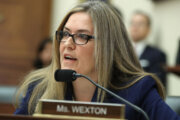From Boston to Indianapolis, racism has been declared a public health crisis in a growing number of cities and counties across the nation. In Ohio, state lawmakers are considering a resolution that would make the state the first to do the same.
As a pediatrician, I know racism is a significant public health crisis in Ohio because I see racism every day. How do I see racism? I see it in the disparities in infant deaths in our neighborhoods, in our cities and in our state. We measure the quality of our public’s health by the infant mortality rates — the death of a live born infant in its first year of life. In our major Ohio cities and in our state, we woefully fail to meet standards. Black infants die two to three times more often than white infants. It’s been this way for generations. Why should that be? How can we fix it?
Ten years ago, I started Moms2B, an Ohio State Wexner Medical Center program to eliminate disparities and address the social determinants of maternal and infant health in Columbus. We began Moms2B with a strong black-white coalition and located our pregnancy group program in our eight Columbus neighborhoods with the highest rates of black infant deaths. More than 3,000 mostly black and brown, pregnant women and their support person have enrolled in our Moms2B and Dads2B programs.
[Read: Parents Talk About Race in Different Ways.]
From our moms and dads, we learn the hard reality of why disparities exist. We see repeated evictions that uproot families and prevent children from sleeping and learning in a safe environment. We hear about the impact of hunger and lack of access to good, healthy food while pregnant. We hear how losing a job while pregnant without maternity benefits leads directly to an eviction and the homeless shelter. We hear how taking two hours on public transportation can make you late for a job or for an appointment and cause you to lose your job.
We’ve learned firsthand the stories of racism. We see black fathers in our Dads2B program who are struggling to find work that will pay the utilities and the rent and put food on the table. Yes, this does happen in white families, too. But for black families, there’s been structural discrimination for generations. There have been real estate covenants, bank red-lining and freeways built through once vibrant neighborhoods. All of these stressful, local events directly affect the health of our black families.
Why disparities in infant deaths? Today, black babies bear the burden of generations of stress and unequal treatment. They’re too often born very early in their mom’s pregnancy. They struggle to breathe in our hospital neonatal intensive care units, to survive those early days, weeks and months of life. They start life at a disadvantage. They live in poorer neighborhoods, more often in a homeless shelter, and go to poorer schools, with disabilities from prematurity. They grow up with the same chronic conditions as their parents, living with more asthma, hypertension, diabetes, severe anemia, anxiety and depression from life’s circumstances, through no fault of their own.
[Read: Parenting in a Divided Nation: How to Preserve Vital Relationships.]
Structural racism can be torn down; implicit racism takes time. I remember my own implicit bias. Even though I’m determined to eliminate disparities, I didn’t know the extent of the anger, the unfair treatment and the attitudes of those who feel superior. I didn’t realize the fear black families feel when they send their black sons and daughters out into their neighborhoods. I believed, as most of my friends and colleagues, that discrimination was in the past. I believed that by electing a black president and first lady we could say “there is no racism” in America. But we all saw George Floyd’s murder and Ahmaud Arbery chased down for a “citizens’ arrest.”
I’ve seen how our own Moms2B and Dads2B programs have eliminated disparities in infant deaths. We’ve changed the public health measure of racism. We’ve lowered infant death rates. I see, to paraphrase the great orator Fredrick Douglass, that we can grow healthy children — and we must grow healthy children. It’s the only way to heal the broken man and to heal our public health crisis.
[Read: How Being Black in America Is Bad for Your Health.]
A real example of what we can accomplish: LaTeeya was pregnant and homeless, living in a shelter with her then 7-year-old daughter. She came to Moms2B and kept coming. We helped find her a home and sent her to community health worker training. She now works for Moms2B and the Ohio State Wexner Medical Center, and she has two beautiful daughters. This shows how we can reach out into the community and help the most vulnerable of us today as well as future generations.
We can tear down structural racism. We can eliminate unequal treatment in evictions, in housing, in policing. We can create stable housing and quality early learning centers in all of our neighborhoods. I see hope, as do many of my black friends. I see black-brown-white, young and old, marching peacefully together, demanding and creating equal treatment for all.
More from U.S. News
11 Ways Rural Life Is Hazardous to Your Health
How to Find Quiet in a Noisy World
10 Reasons to See a Physician Assistant
‘I See Racism Every Day,’ a Pediatrician Says originally appeared on usnews.com







